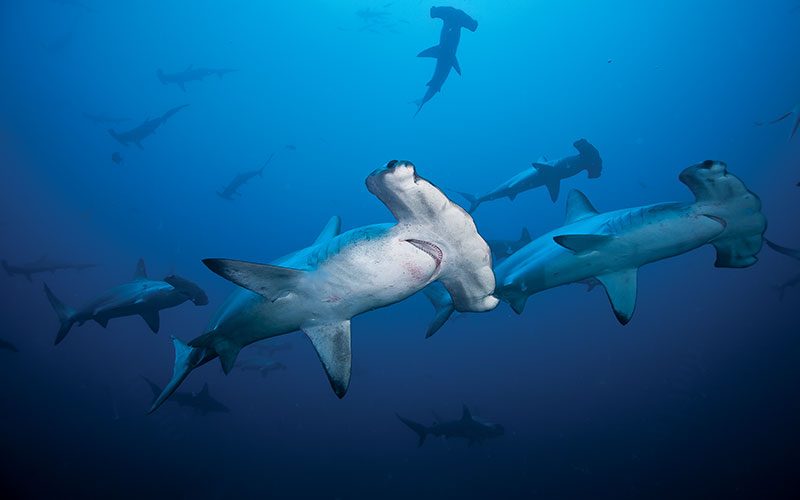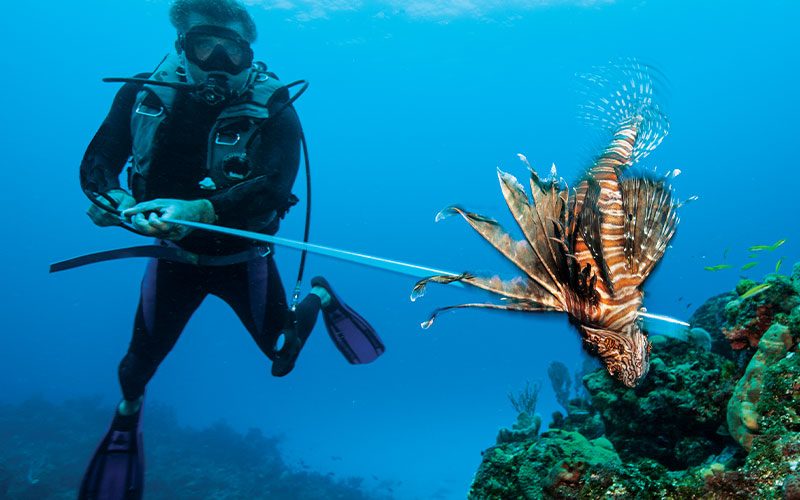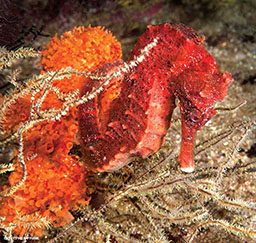Cocos Island National Park, a United Nations Educational, Scientific and Cultural Organization (UNESCO) World Heritage Site, sits a day-and-a-half boat ride off the Pacific coast of Costa Rica. In the waters that surround the island, hundreds of scalloped hammerhead sharks wait their turns at cleaning stations around the reefs. Groups of whitetip reef sharks glide through the water alongside individual blacktip, silky and Galapagos sharks, while the occasional massive whale shark plows to the surface. Meanwhile, dozens of marbled and eagle rays — along with pods of bottlenose dolphins, enormous schools of jacks and endemic fish found nowhere else on the planet — join the shark fest.
“It’s the most incredible underwater place I’ve ever been,” says Todd Steiner, executive director of the California-based Sea Turtle Restoration Project. “It’s a superhighway of giant animals — like the plains of Africa, only underwater.”
Steiner explains that, for hammerheads, being cleaned is akin to receiving a massage. Human observation does not appear to affect the behavior at all: “The hammerheads are calm and just slowly cruising, and they’ll look right at you.” Even human behavior can change in the Cocos: “In most places, when you see a shark you call everybody over to look, but here you see so many sharks and rays that you stop noticing them,” Steiner says. “The schools of fish go 60 feet up and down and as far as you can see — tens of thousands or even hundreds of thousands. For me, it’s like seeing what the oceans must have been like hundreds of years ago.”
Because Cocos Island is both remote and protected, it can be difficult to visit, and only the most serious marine wildlife enthusiasts make it there. When divers travel to Cocos, they’re often visiting for something more than simply viewing the spectacular marine life — many of them are volunteering to participate in research aimed to protect the organisms that live in those waters.

Most Cocos Island research seeks to determine whether the underwater park is large enough to protect the endangered species there. Preliminary data suggest that most of the animals are residents rather than just transiting through. Even though they spend the majority of their time within the no-take zone, however, they also occasionally wander out of it. A larger area would provide more protection. “It’s great for sharks and sea turtles to be protected at Cocos,” Steiner explains, “but as soon as they leave, they fall victim to longline fishing. We see sharks and sea turtles with hooks in them all of the time.” And these are only the ones who make it back to the island’s protected waters.
Because the animals regularly move outside of the protected areas, a related research question regards how species at Cocos are connected to those in the surrounding Eastern Tropical Pacific islands. Steiner’s work indicates, for example, that hammerheads tagged at Cocos routinely swim to the Galapagos and to another island off the coast of Colombia. Tissue samples from the animals also provide genetic information that helps determine the relationships between different organisms. This genetic research demonstrates that green sea turtles migrate to Cocos from the Galapagos, mainland Ecuador, Mexico, Costa Rica and the Western Pacific. “Even though Cocos is a foraging area for animals from around the world,” Steiner says, “and green sea turtles spend their teenage years here because it has good food resources to help them grow to sexual maturity, the question remains whether the marine reserve is big enough.”
In the case that the reserve is not big enough to protect all of the species that find either temporary or permanent homes in the protected area, Steiner also wants to document the need for designated pathways that will allow marine life to safely move between marine protected areas. Data showing the connection between Cocos and the Galapagos, for example, bolsters the argument in favor of a protected swimway between these ocean hotspots.

Brad Nahill, director and cofounder of SEEtheWILD, one of the nonprofit organizations that connects travelers with volunteer and wildlife conservation programs, including the one at Cocos Island, points out that protecting wildlife is a big job and the people who are doing it need help, especially in underwater habitats. Divers possess unique skills that allow them to contribute in a number of ways, including cleaning up debris (especially old fishing gear), clearing invasive species and collecting information about coral reefs and other organisms. The extra help is especially vital in countries where governments invest too few resources in protecting the marine habitats on which locals often depend for their livelihoods. For researchers, volunteer divers represent much-needed practical and financial support.
At Cocos Island, expedition leaders teach volunteer divers how to capture, weigh, measure and tag sea turtles as well as how to apply acoustic or satellite transmitters. This year Cocos volunteers will help add to the 150 sharks and 74 sea turtles tagged on previous expeditions and recover data from underwater acoustic receivers. Mark Stabb, a mechanical engineer from San Diego who recently participated in his seventh Cocos Island shark and sea turtle research trip, says he combines diving with volunteering for two main reasons: “First, it’s an experience you’re not likely to get anywhere else. You’re working with researchers, seeing and doing things that you can’t always see and do. If you go to Hawaii and put your hands on a turtle, you’ll pay a big fine, but at Cocos I’ve personally caught probably a dozen green turtles so they can be weighed and measured. Second, you’re also doing something beneficial for the world by helping to make sure that others will be able to see these animals as well.”

Capturing a sea turtle on a dive is an amazing experience, but volunteer divers at Cocos can do as much or little of the scientific work as they want. Stabb, who considers himself a hands-on person, tries to do everything, but he also recognizes the value of volunteers who choose to observe: “I’ve seen plenty of people who come and are happy just to watch, and Todd [Steiner] is happy to have them. Having people along is effectively funding the research.”
For volunteers at Cocos, the opportunities to engage in a variety of tasks are many. Nonie Silver, a Washington, D.C., business owner and participant on many of the Cocos Island expeditions, says she often serves as the logistics person: “The shark tags need to be prepped and tasks defined for each of the dives, whether we’re retrieving receivers, catching turtles or tagging sharks. For example, when we catch a turtle, there are a series of steps that need to be completed before the turtle can be released back to the sea.
“It makes you feel good that you’re doing something to help,” Silver continues. “In other places you see the lack of fish or coral, and it makes you appreciate the fact that this one little thing you’re doing may help the ocean.”
Volunteers can also help by taking photographs; the researchers maintain a photo identification library in cooperation with local dive operators. These photos, Steiner explains, help him track individual animals even when he isn’t there in person.
Tagging sharks is a bit trickier because it involves using a spear to inject a tag at a specific point on the shark’s body. The Cocos Island National Park’s rules require that volunteers who would like to help with this task have a scientific background and relevant experience, but anyone can help count sharks and rays, which is an important element of documenting population trends. For these jobs, divers receive instruction in species identification and survey techniques and then use an underwater slate to record location, time and depth at five-minute intervals for each species they spot. Still other volunteers remain on the boat and record this data on computers.
Cocos Island provides only one of the many opportunities to contribute to marine science and conservation work. In other locations, the Reef Environmental Education Foundation (REEF) asks volunteers to help cull the increasing numbers of invasive lionfish prowling their favorite dive sites. The organization is documenting the consequences of the lionfish invasion in hopes of ultimately minimizing its effect on native fish populations. Under the direction of Lad Akins, REEF director of special projects, and Peter Hughes, founder of DivEncounters Alliance, up to 20 divers at a time can participate in lionfish collection and dissection in addition to reef fish surveys.
Pam and Terry Hillegas of Englewood, Colo., have taken six REEF lionfish trips to various locations and say that their trips have made them more aware of the ways that invasive species can affect the ocean. According to Terry, the service and educational aspects of the trip added an enormous amount of value to his experience: “That really made the whole experience more interesting for us. I feel like I’m doing something beneficial and not just enjoying recreational diving.”
“Lad and Peter are very knowledgeable and show you how to correctly handle lionfish so you don’t have any mishaps,” Pam adds. “It’s amazing how comfortable they can make you feel handling these fish.” Those who are interested in taking these expeditions but don’t care to spear or bag lionfish can also do surveys to count the lionfish and the other species on individual reefs.
Organizations such as REEF have a larger effect on the environment than one might think. “I dive quite a bit in the Caribbean and realize the damage that lionfish do,” says Calvin Roggow, a volunteer from Oklahoma. “REEF seems to be at the forefront of actively trying to control them. We go back because the trips are so enjoyable; it’s really a great time, and you’re doing a good thing for the ocean.”
For divers looking to travel a bit farther afield, Projects Abroad offers two land-based volunteer diving projects in Southeast Asia — one in Cambodia and the other in Thailand.

On the Cambodian island of Koh Rong Samloem, a two-hour boat ride from the coast, divers help survey marine habitats as well as coral and fish diversity, focusing specifically on seahorses. “We work with an organization called The Seahorse Trust, which collects data to track migrations and populations and support their preservation,” says Projects Abroad program advisor Christian Clark. More than 150 million seahorses are taken from the wild each year for use in traditional Chinese medicine, while the souvenir and pet trades take another million or so each. These programs aim to help protect seahorse species from exploitation.
The beachfront, four-person wooden bungalows at Koh Ron Samloem have bathrooms, bucket showers and a few hours of generator-provided electricity each evening. Everyone dines in a communal area with space to relax, play games and enjoy the view from a hammock. “Sea turtles are commonly seen on the reef, and you’re pretty much guaranteed to see seahorses, which are fairly rare and very cool,” Clark says.

Volunteers can assist in beach and underwater clean-up, in addition to teaching conservation and sustainable practices at the village school and through community projects. Program participants also help tally shark sightings for the organization’s Global Shark Campaign, which spans 18 countries.
The Thailand project aims to protect and rehabilitate Thailand’s coral reefs, marine ecosystems, tropical forests and the animals that live in these habitats. For these efforts, volunteer divers conduct reef and debris surveys, collect data and perform salvage dives to remove fishing nets and other debris from the reefs. For the land-based work, the program teams up with a local conservation organization that focuses on the forest. Volunteers also work with locals: “We have done school programs, such as working with children to start a tree nursery,” Clark says, “and we also do beach clean-ups and other activities in the community.” One particularly popular activity, for example, included a release of mangrove crabs and sea snails.
In the Caribbean, the Oceanic Society monitors and assesses the overall health of coral reefs around Turneffe Atoll off the coast of Belize. Society researchers provide training in sampling techniques and the identification, behavior and distribution of local fish and invertebrates. During six days of diving, volunteers spend about four hours a day collecting data and are able to enjoy purely recreational diving the rest of the time. The research helps direct marine management efforts, providing evidence of how human activities affect the reefs.
For these projects and similar opportunities, voluntourists come from all over the world. The opportunities are ample for divers, but nondiving family and friends can also participate in land-based activities or take advantage of dive certification courses (up to advanced open-water level) that are offered as part of the trip package.
Combining volunteering with a dive trip not only benefits the marine environment and local communities, but it also proves to be memorable for those who participate. “It provides life-changing experiences for travelers,” Nahill says. “There is no deeper way to build a connection with a place than by leaving a legacy of conservation behind.”
© Alert Diver — Q4 Fall 2014